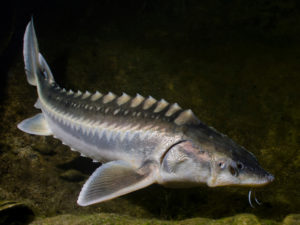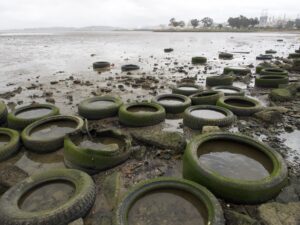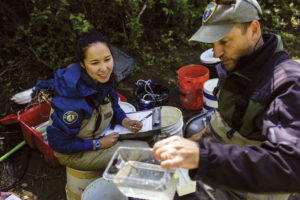Gordon Becker, a senior scientist with the Center for Ecosystem Management and Restoration (CEMAR), is setting up a field lab in the shallows of a bank on Pescadero Creek, about a mile and a half upstream from where it spills into the Pacific. The creek here, just on the outskirts of the town of Pescadero, is shaded by alders full of chattering songbirds. A net spans the 15-foot width of the creek. The rig is called a fyke net, Becker explains, and it funnels whatever is coming downstream into a single collection point, a live trap. This morning something big is splashing in the trap.
Becker is leading a regional monitoring program to see how many young steelhead, called smolts, are swimming downstream. Besides Pescadero Creek, Becker and CEMAR have traps set up on Corte Madera Creek in Marin, the Napa River, and Sonoma Creek, which drain to San Francisco Bay. “This is the first comprehensive approach to studying steelhead outmigration in Bay Area and coastal San Mateo creeks,” Becker says. CEMAR’s smolt study will help gauge the effectiveness of the substantial regional watershed restoration efforts undertaken in these watersheds. “What we are trying to figure out,” Becker says, “is if the smolts leaving the watershed are big enough to come back.” Smolting usually begins when anadromous fish (which spawn in freshwater but mature in the ocean) are two years old. This brief period of their life cycle marks the transition from a predominantly freshwater species to a saltwater species. The optimal size for a young fish heading out to sea for the first time is about 10 inches. Smaller than that and survival rates at sea plummet.
In the creek, Becker is cleaning out the live trap. First he removes a cover, an improvised tarp designed to keep out a resident heron he suspects is raiding the trap. Then he reaches in the cold water and pulls out a glimmering adult steelhead almost the length of his arm. Becker guides it gently downstream, then pulls out another adult steelhead. After that there are only small fish left.
“Steelhead have two life history strategies,” Becker says. “They can either become resident freshwater fish (rainbow trout) or they can go to the ocean. We have information about where juveniles can be found and we know the distribution of steelhead in Bay Area streams, but with outmigration studies, we can figure out which streams are producing oceangoing fish. Only the most productive habitats are producing smolts.”
Becker’s goal is to document the presence of young migrating steelhead and the size and frequency of fish leaving the creek: “This information is important for assessing the health of the steelhead population and it will give us a better understanding of how to protect critical habit.” The project, in its first year, is funded by the Bay Area Integrated Regional Water Management Plan.
Becker and the CEMAR biologists working at the other sites have learned a lot about trapping in their first smolting season, over about 100 days this spring. They hope to continue the study in other watersheds next season and eventually create a smolt data baseline.
The study would likely not have been possible without volunteers who help check traps and measure fish at each site. “Each location has its own network of volunteers,” Becker says, “which cuts the cost of the study by about half.” The volunteers were recruited by conservation organizations and agencies in each area, including the Sonoma Ecology Center, the Napa County Resource Conservation District, and the San Mateo County Resource Conservation District.
During this trap check on Pescadero Creek, Becker collects and measures two dozen young steelhead (after sending the two adults and native prickly sculpin on their way downstream). Most of the young fish will spend months feeding and growing in the estuary downstream before leaving for the ocean.
Knowing where they’re doing that successfully is key to the species’ long-term survival: “In an ideal world you find out which habitats are producing these fish, you analyze the threats to those habitats, and you take action to reduce those threats,” Becker says. “Then you can expand from there and start thinking about recovering the species.”




